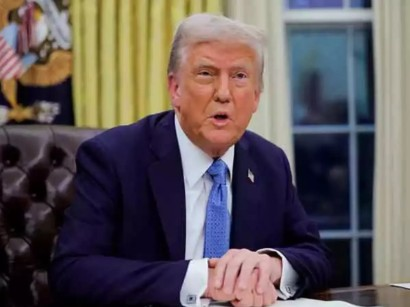U.S. stocks roared back on Tuesday, staging a dramatic rebound fueled by hopes that the White House might soften its stance on tariffs after President Trump announced that Japan would dispatch a delegation for trade talks. Investors, rattled by fears of a deepening global trade war, found a glimmer of optimism in signs that negotiations could be on the horizon.
The Nasdaq Composite led the charge, climbing 4.24% as tech stocks powered higher. A key semiconductor index surged more than 5%, underscoring the relief rally in a sector seen as particularly vulnerable to escalating trade tensions. The S&P 500 gained 3.77%, while the Dow Jones Industrial Average jumped nearly 1,400 points, or 3.68%, marking one of its strongest sessions in recent months.
“The market was extremely oversold coming into today,” said Adam Sarhan, CEO of 50 Park Investments. “Investors are reacting to the possibility that cooler heads could prevail on tariffs. But nothing is resolved yet — this could be a pause, not a pivot.”
The catalyst came from Washington, where President Trump announced that Japan would dispatch a delegation for trade talks. The move follows his recent declaration of a 25% tariff on imported autos, a policy that rattled Asian markets and prompted warnings from economists about the risk of recessionary spillovers.
Japan, heavily reliant on auto exports, quickly responded, with Prime Minister Fumio Kishida expressing concern over what he called a “destabilizing” approach to global commerce. South Korean officials also entered the fray, with acting President Han Duck-soo holding talks with Trump on broader trade issues including shipbuilding and energy exports.
The renewed diplomatic activity helped fuel a global rally. Europe’s STOXX 600 index advanced 3.69%, and Japan’s Nikkei 225 soared 6%, its best day in more than a year. MSCI’s benchmark of world equities climbed 3.4%, snapping a three-day skid.
Back in the U.S., market participants are also gearing up for the start of corporate earnings season — another potential catalyst. “If the numbers come in strong, that could lend more stability to this rally,” Mr. Sarhan said.
Yields on U.S. government bonds also moved sharply higher for a second straight day, a sign that investors may be pricing in reduced recession risks. The benchmark 10-year Treasury yield rose to 4.24%, while the two-year yield hit 3.84%.
Meanwhile, currency markets remained jittery. The dollar index edged lower, weighed down by the uncertainty in trade policy, while the Japanese yen gained ground against the greenback. The Chinese yuan weakened further, trading at 7.373 to the dollar in offshore markets, as Beijing pushed back on Washington’s latest threats.
Crude oil prices inched higher, with U.S. benchmark crude settling above $61 per barrel. Brent crude rose to nearly $65, buoyed by the broad risk-on sentiment.
Still, volatility remains the name of the game. President Trump doubled down on his stance with China, warning of additional 50% tariffs should Beijing maintain its retaliatory measures. Chinese officials responded with sharp language, saying they would not “yield to economic coercion.”
For now, markets are betting — cautiously — that diplomacy might yet avert an all-out trade conflict. But with headlines shifting by the hour, investors aren’t ready to declare the storm over just yet.
“We’re in a fragile place,” said Sarhan. “Hope is driving this bounce. But hope isn’t a policy.”



